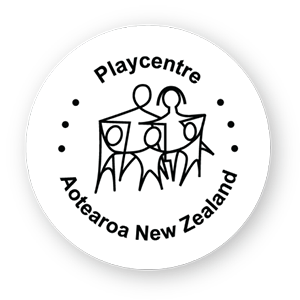He Kupu whakataki – Introduction
What is Matariki
I ia tau, i te wāhanga o te takurua, ka kōwhitiwhiti mai a Matariki e rikoriko ana i te rangi i te ata hāpara. I te ao Māori, koia nei ia te tohu mō te tīmatanga o te tau hōu; he wā tēnei hei maumahara me te poroporoaki i ngā mate, hei whakanui i te ao mārama me te āwhio o te ora; hei aro hoki ki mua ki te tau e heke mai. Nā reira, i tēnei rautau, kua whakarauora ēnei ritenga, ā, he maha ngā momo mahi i Aotearoa hei whakanui i a Matariki.
Ko Matariki te kāhui whetū e kīia ana e te Pākehā, ko Pleiades. Tārewa tū ai a Matariki i Aotearoa i te marama o Pipiri, i te Hōngongoi rānei. He rerekē ngā rā i ia tau, nā te mea ka whai Maramataka ēnei tikanga. Hei te ata pō ka kitea a Matariki i te pito o Te Ika-whenua-o-te-rangi (Milky Way), e tārewa ana i te pae o te uru-mā-rāwhiti.
Kei tēnā iwi, kei tēnā iwi āna tikanga, tōna wā hei whakanui i a Matariki. Ko ētahi iwi ka whakanui i te putanga mai anō a Matatriki me tōna matenga hei te mutunga o te marama, ko ētahi iwi ka tatari kia hua te marama, ko ētahi atu iwi ka tatari kia kōwhiti te marama hōu. Ki ētahi iwi e iwa ngā whetū, ki ētahi e whitu noa. Ka whakanui ētahi iwi i a Puanga/Puaka hoki.
Heoi, kei tēnā iwi, kei tēnā iwi Māori āna momo kōrero, āna waiata, āna whakataukī hei whakanui i a Matariki.
Every year during winter twinkling in the sky just before dawn, Matariki (the Pleiades) signals the Māori New Year. Traditionally, it was a time for remembering the dead, celebrating new life, reading signs for the upcoming new year, and planning for the future. In this century, observing Matariki has been revitalised, and is celebrated in a number of different ways in Aotearoa.
Matariki is the Māori name for the small cluster of stars also known as the Pleiades in the Taurus constellation. In Aotearoa Matariki reappears in June or July. This date changes each year as tikanga Māori follow the lunar calendar. Matariki comes into view in the tail of the Milky Way, low on the north-eastern horizon just before dawn.
Various Māori tribes celebrated Matariki at different times. Some held festivities when Matariki was first seen in the dawn sky; others celebrated after the rise of the full moon or at the beginning of the next new moon. Iwi recognise differing numbers of stars within the constellation Matariki, some iwi also recognise and incorporate the star Puanga or Puaka. There are different knowledge and traditions relating to the meanings of the stars.
When to observe Matariki
“The optimum time to observe the rising of Matariki is in the phase of the moon known as Tangaroa, the moon of plenty. The Tangaroa moon phase occurs in the three or four days leading to a new moon and will fall on different dates each year”. https://www.twoa.ac.nz/hononga-stay-connected/te-iwa-o-matariki?sc_lang=en
Matariki dates for future years
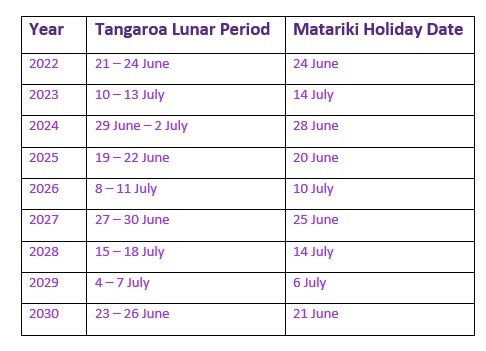
Kāhui Whetū o Matariki – Stars of the Matariki Cluster
To Matariki the stars that herald the return of light bringing life, new growth.
Tupuārangi (Atlas) Tupuānuku (Pleione)
Waipunarangi (Electra) Pōhutukawa (Sterope)
Waitī (Maia) Hiwa-i-te-rangi (Calaeno)
Waitā (Taygeta) Ururangi (Merope)
Reference: Moorfield, J. (n.d.). MāoriDictionary. Retrieved from https://maoridictionary.co.nz/search?idiom=&phrase=&proverb=&loan=&histLoanWords=&keywords=Matariki
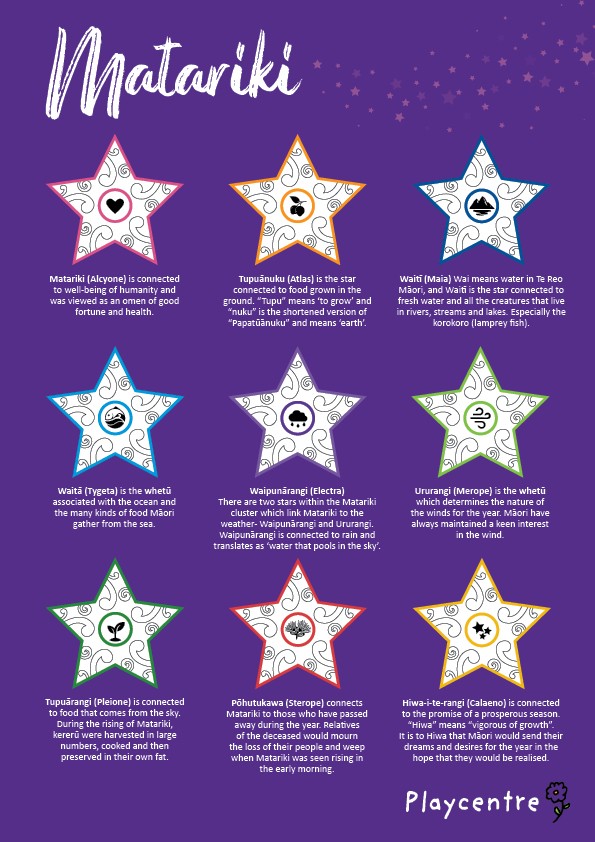

Matariki (Alcyone) is connected to well-being of humanity and was viewed as an omen of good fortune and health. Our ancestors would gather the ritual offerings of produce from their gardens to Matariki as mentioned in the following saying: “Ngā kai a Matariki nāna i ao ake ki runga” – “the food of Matariki that is scooped up with both hands”. The offerings were to ensure providence for the following year to bestow favourable conditions for bounty upon the world below.
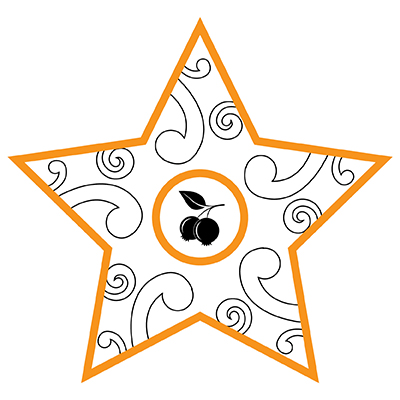
Tupuānuku (Atlas) is the star connected to food grown in the ground. “Tupu” means ‘to grow’ and “nuku” is the shortened version of “Papatūānuku” and means ‘earth’. When Matariki sets in the western sky at dusk during the month of May, the harvesting of the garden has been completed and winter is near. Our ancestors planted a sacred garden at the rising of Matariki known as “Te Māra Tautāne”. All the produce grown within Te Mara Tautane were offered to Rongo the Māori god of cultivation, and to the star Matariki. A kūmara, for example, might be offered to Tupuānuku, and a kererū or another bird from the forest offered to Tupuārangi. Likewise, an eel or freshwater fish would represent Waitī, and some form of shellfish or sea life would be chosen for Waitā. Only the best foods would be offered.

Waitī (Maia) Wai means water in Te Reo Māori, and Waitī is the star connected to fresh water and all the creatures that live in rivers, streams and lakes. Especially the korokoro (lamprey fish).

Waitā (Tygeta) is the whetū associated with the ocean and the many kinds of food Māori gather from the sea.
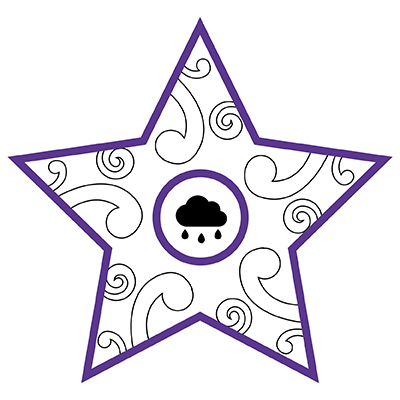
Waipunarangi (Electra)
There are two stars within the Matariki cluster which link Matariki to the weather – Waipunarangi and Ururangi. The appearance of these stars at the rise of Matariki would forecast the weather for the new year. Waipunarangi is connected to rain and translates as ‘water that pools in the sky’. In fact, Tāpuapua means “lying in pools” and the rainy season is known to Māori as Te Matariki Tāpuapua.
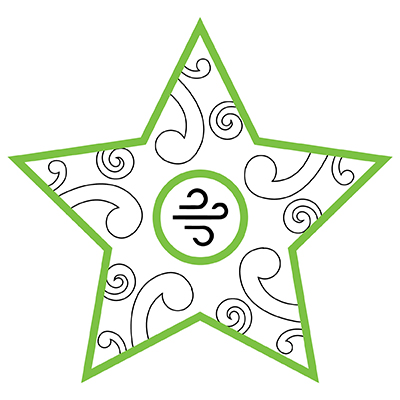
Ururangi (Merope) is the whetū which determines the nature of the winds for the year. Māori have always maintained a keen interest in the wind. Manu Aute or traditional Māori Kites played an important role in traditional times in understanding the wind and its behaviour. They were usually made of raupō, cutty grass or flax. The frames of the kites were made from kareao, mānuka, or toetoe.
Manu Aute also had many uses: for fun or fishing, for war, and occasionally as sails to drive canoes. Throughout the Pacific kites were usually made with Aute, the bark of the paper mulberry, which is also used to make tapa.
The Māori word for bird is ‘manu’ and it is in the shape of a bird that they made their kites. It was believed that birds could carry messages between humans and gods.
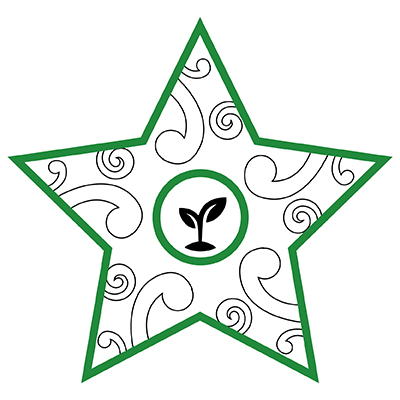
Tupuārangi (Pleione) is connected to food that comes from the sky. During the rising of Matariki, kererū were harvested in large numbers, cooked and then preserved in their own fat. Tupuārangi is the star that connects the cluster to the harvesting of birds and other elevated food products like fruit and berries from the trees.
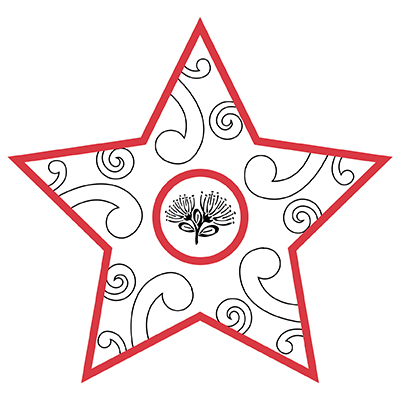
Pōhutukawa (Sterope) connects Matariki to those who have passed away during the year. Relatives of the deceased would mourn the loss of their people and weep when Matariki was seen rising in the early morning. It is through Pōhutukawa that Māori remember those who have died in the past year. As mentioned in the following saying for those who have passed on into the night having made the journey to Te Rerenga Wairua never to return: “Takitahi ngā whetū o te kāhui Matariki i te ara i takahia nei e rātou kua haere noa atu ki te pō” – “Follow the stars of Matariki and in the footprints of those passed into the night”.
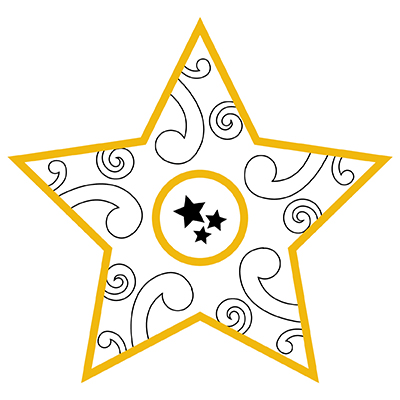
Hiwa-i-te-rangi (Calaeno) is connected to the promise of a prosperous season. “Hiwa” means “vigorous of growth”. It is to Hiwa that Māori would send their dreams and desires for the year in the hope that they would be realised. Similar to the notion of wishing upon a star or making a new year resolution.

